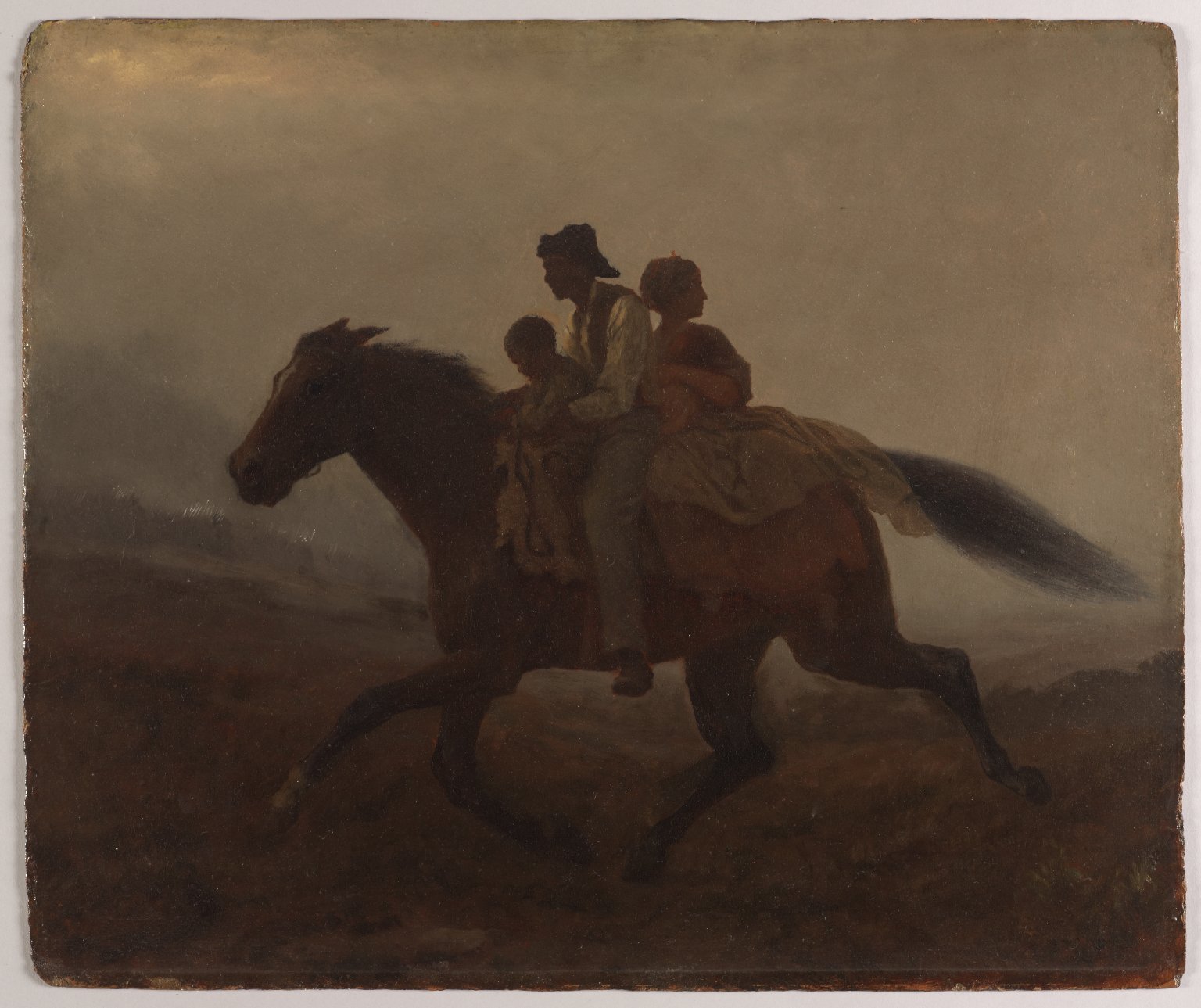Eastman Johnson’s A Ride for Liberty — The Fugitive Slaves, c. 1862 will be useful in the study of:
- African American history
- The Civil War
- Slavery in the United States
- Abolitionism in the United States
- Politically-engaged art
- American and regional culture
- Migration and settlement
By the end of this lesson, students should be able to:
- Discuss A Ride for Liberty — The Fugitive Slaves as a primary document that links to its specific historical context during the nineteenth century.
- Discuss the ways in which this painting is different from other representations of African Americans at the time

Eastman Johnson, A Ride for Liberty — The Fugitive Slaves, c. 1862, oil on paper board, 55.8 x 66.4 cm (Brooklyn Museum)
1. Look closely at the painting
Look closely at A Ride for Liberty — The Fugitive Slaves (zoomable images, also available for download for teaching)
Questions to ask:
- Describe the painting. How has the artist shown us what is important?
- What details in the painting might be important?
- What mood would you associate with this painting?
2. Watch the video
The video “A dangerous escape to freedom: Eastman Johnson, A Ride for Liberty — The Fugitive Slaves” is only four minutes long. Ideally, the video should provide an active rather than a passive classroom experience. Please feel free to stop the video to respond to student questions, to underscore or develop issues, to define vocabulary, or to look closely at parts of the painting that are being discussed. Key points, a self-diagnostic quiz, and high resolution photographs with details of A Ride for Liberty — The Fugitive Slaves are provided to support the video.
3. Read about the painting and its historical context
A desperate chance
A Ride for Liberty — The Fugitive Slaves is based on an event Eastman Johnson said he witnessed at a Manassas battlefield during the Civil War, as a family fled slavery and made a desperate ride for the Union line. The title alludes to the Fugitive Slave Act, which allowed slave hunters to seize fugitive slaves without due process and prohibited anyone from aiding escaped fugitives. Northern reluctance to comply with the Act was one of the conflicts between North and South that led to the Civil War. With the beginning of the war, the Act no longer applied. Enslaved persons who could make it to the Union armies were considered contraband of war and were freed. Formerly enslaved people were of great benefit to the Union army, providing intelligence on land and troops, and many also fought in the war.
A different depiction
Eastman Johnson’s depiction of the African American family on the horse was a departure from the majority of depictions of African Americans in art at the time. Most were stereotypes based in racial prejudice, which exaggerated aspects of their appearance and showed them as almost grotesque. Even abolitionist art of the time, which was meant to promote the end of slavery and empathy for enslaved people, depicted African Americans as passive or begging for help. Johnson instead has chosen to depict the family as individuals, with varying skin tones and facial features. He also shows them taking charge of their own destiny, and risking their lives in the process.
4. Discussion questions
- The video narrators both wonder how Eastman Johnson’s Ride for Liberty would have been received had it been exhibited in the year it was painted. Think about how many different kinds of viewers there might have been for this painting. How would their reactions have been similar or different depending on their identity and perspective?
- Think about your first impression of the painting, before you knew more about its meaning and context. Was the artist able to communicate the meaning of the work of art to you easily, or did you need to know more about the work? What other works of art (visual, literary, or musical) do you think might have a similar feel to this painting?
5. Research questions
- Henry Ossawa Tanner’s painting The Banjo Lesson addresses the legacy of American slavery and racial prejudice at the end of the nineteenth century. Compare Tanner’s painting with A Ride for Liberty — The Fugitive Slaves, and discuss how they approach their subject matter and meaning. How are they similar? How are they different?
- The video briefly shows some objects made to promote abolition in the United States. Find two or three examples of these works (some examples are here, here, here, and here). What kind of images were used to plead the case for abolition? How are they different from the kind of fine art painting that Eastman Johnson made?
6. Bibliography
Explore a lesson plan on using primary source documents related to runaway slaves
Read a biography of Eastman Johnson at the National Gallery
Read about how artists addressed the Civil War at Smithsonian Magazine
Patricia Hills. “Painting Race: Eastman Johnson’s Pictures of Slaves, Ex-Slaves, and Freedmen”, In Teresa A. Carbone and Patricia Hills, ed., Eastman Johnson: painting America, pp. 121-165 (Brooklyn Museum of Art, 1999)





